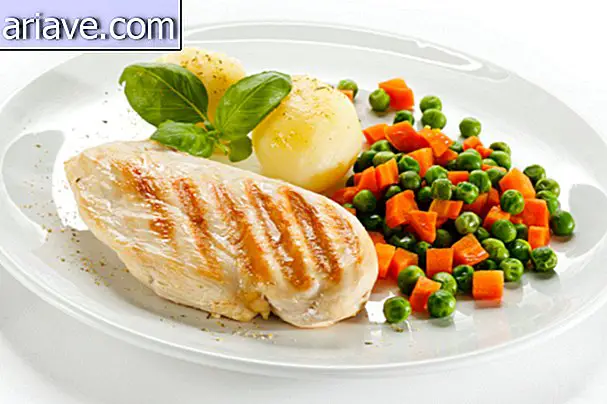Learn how to assemble a healthy and balanced dish

Every time you go to a buffet a pound, it is common for you to fill the whole dish with almost all the options the place offers and still make a mountain of food, thinking that if you do not, you might go hungry? And when you're home, with the meal platters on the table, do you repeat until your stomach is full and almost always leave the salad aside?
If you have identified with these situations, chances are you may not know how to balance your daily diet to follow a healthy diet and may also be slightly overweight. Did we get it right? Whether you are in this profile or not, the important thing is that we must know how to evaluate our food addictions, which can be recorded in our memory since we were children.
Since our childhood we have been encouraged to eat well to “grow strong”. However, this does not mean that we must extrapolate and eat too much. However, many people bring some habits of this phase, which for the adult life may not be very healthy.

An example? Put too much food on the plate and scrape it all to the end even after the hunger has passed long ago. Of course, what cultural aspects come into this question, but sometimes you have to ask yourself: Do I really need this amount of food right now? The result can be extra pounds and even impaired digestion.
In addition to these situations, you need to know exactly what is on the plate. Vegetables, protein and carbohydrates should be present daily, making a healthy and nutritious mealtime balance.
According to nutritionist Melissa Santos, an ideal dish is made up of leaves, vegetables, whole carbohydrates, grains and lean protein. But how to balance the portions of each food group?
Balance and health
Whether for breakfast, lunch or dinner, it is important to always have healthy foods included in these meals and snacks in between, which can be made with fruits, non-fat yoghurt, gelatin, natural juices, cereal bars or whole crackers.
When in a restaurant, try to resist temptation and not use the entire surface of the dish. In some buffets per pound, the plate is already larger, resulting in too much food and poor health. So keep an eye out and try not to overdo it. Let go for salads, which are low in calories, high in vitamins and fiber.

Some fitness traps also appear in international cafeterias and restaurants, which offer such caloric mega-steamings. This type of meal was taking over the gastronomic market of our country, offering huge and usually delicious dishes. It is best not to surrender to these temptations, but if unavoidable, share with a friend (or mother, husband, boyfriend), or prefer smaller options that have fewer calories and saturated fat.
When it comes to amounts, if possible, you should consult a nutrition professional who will evaluate your profile, taking into account weight, height, gender, age, physical activity and your goals.
However, there are valuable tips on how to divide well the portions of food on the plate that will fit all people. But first, you need to know more about the builder, energy and regulatory foods that form the ideal balance on your plate as part of a healthy diet.
Builder, regulator and energy foods
Builder foods are protein-rich foods that provide the essential nutrients for the formation of skin, muscles, bones and our entire body. This group consists of foods such as meat (beef, chicken and fish), milk and dairy products, eggs, grains, and cereals such as beans, quinoa, brown rice, lentils and chickpeas.

In addition to these foods, which are the most protein-rich, there are many others with a significant amount of protein that can come into your daily meals.
Regulatory options are foods made up of vitamins, fiber, minerals and water, and these nutrients are found in vegetables, fruits and fruits. In addition to these benefits, regulatory foods are low in calories and also have fiber, which is important for digestion and proper bowel function.
Lastly, energy foods, which are carbohydrates. This category includes potatoes, rice, corn, breads, cassava, parsley potatoes and tubers in general. In addition, give preference to wholemeal energy choices of rice, pasta and breads, which also offer high carbohydrate concentrations.
With that in mind, it is easier to maintain a balance on the plate and make a division of optimal portions, which you check below.
Split and balance
It is certain and fully proven that a well-colored dish is synonymous with healthy eating, following the principle of containing the important food groups for proper nutrition. To properly distribute these foods is simple.

According to nutritionist Melissa Santos, the indicated is to divide the dish in four equal parts. But first of all make a plate of raw salad containing green, yellow, red and white vegetables first. Which ones are they? Check out some examples below:
- Yellows: pumpkin, carrot, corn, yellow pepper;
- Whites: onion, chayote, mushroom, cauliflower, turnip, heart of palm, radish and cucumber;
- Greens: zucchini, chard, lettuce, okra, cabbage, watercress, green peppers, broccoli, chicory, string beans, kale, spinach, arugula and endive;
- Reds: beets, red peppers and tomatoes;
After the salad, which will provide a little satiety, assemble the dish with the rest of the groups, dividing it into four parts. Check out a suggestion indicated by the nutritionist:
- ¼ plate: Steamed vegetables (include foods such as squash, zucchini, carrots, broccoli and cauliflower). It is recommended that you consume a portion that is the size of your closed hand, also valid for the two items below;
- ¼ platter: carbohydrates such as brown rice or cassava or potato or whole wheat pasta;
- ¼ plate: legumes such as beans or lentils or chickpeas or peas crooked or quinoa;
- ¼ plate: Proteins like chicken breast or fish. Lean meat should be eaten once a week or at most twice. To measure the protein portion on the plate, a tip is to consume a piece the size of your palm.
You can substitute the foods on the menu suggested above according to the protein, vegetable, grain and carbohydrate food groups.
Tips and tricks
There are a few ways to reduce portion sizes and to control yourself more during meals. Importantly, this type of recommendation is not just a matter of fitness, but of leading a healthier life in order to maintain well-being and prevent disease.

By following a few minor changes in your daily life, you may feel better and lighter. Check it out below:
Chew food more slowly, as this way the satiety center is activated, leaving our body satisfied faster;
When you are home, try lunch and dinner dessert plates and cutlery. You will put smaller portions and be satisfied just as you would if you used a large plate;
Also at home, try not to have at the table where you are going to eat that pile of platters full of food in front of you. With all the abundance available, you tend to repeat over and over without even being hungry. Therefore, make a test by leaving meals on the stove. So you make the plate and go to the table. You will see how it makes a difference.
* * *
If you're looking for a change in diet, whether you want to put more nutritious options on the menu, or want to stay fit, take advantage of the suggestions above and have a more balanced and healthy life.











